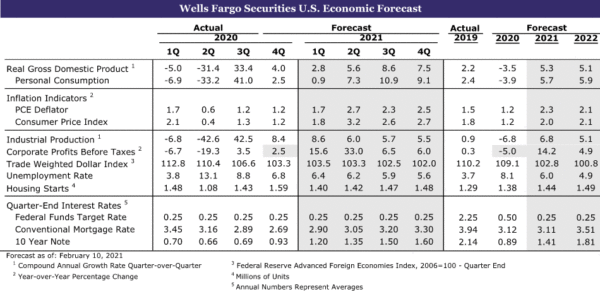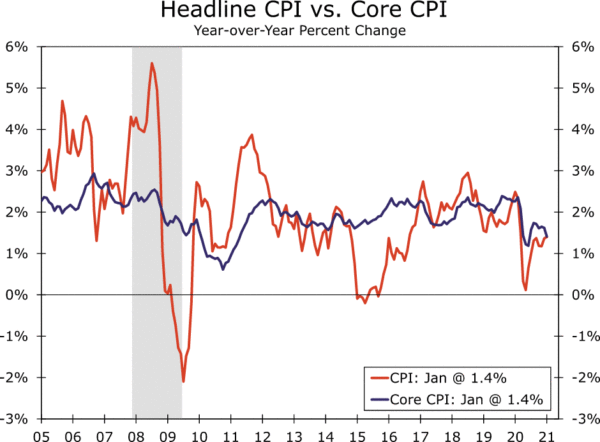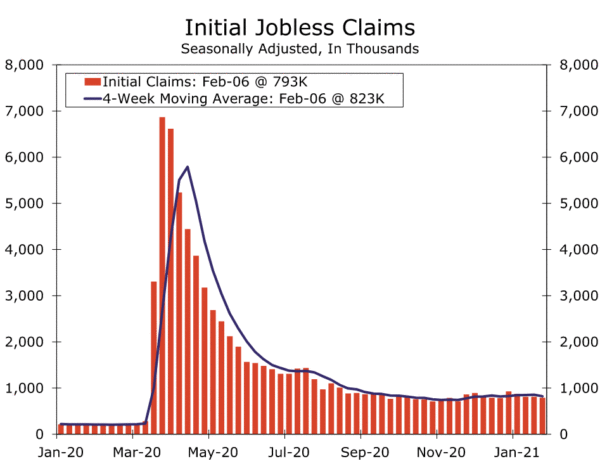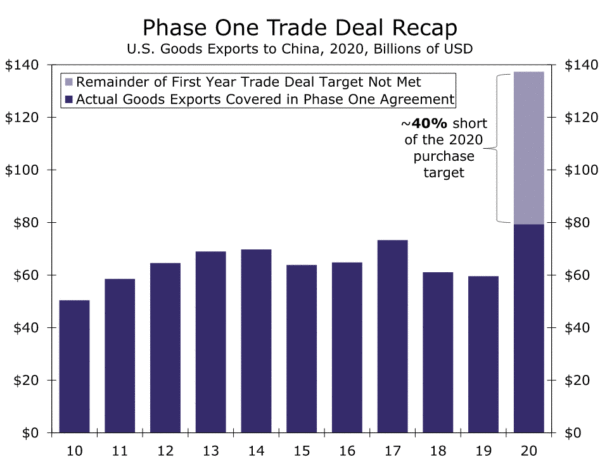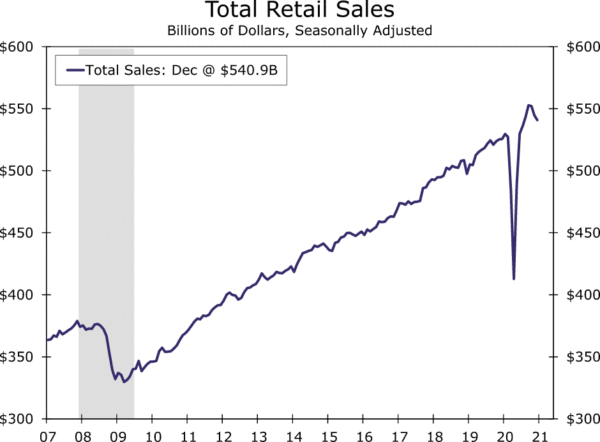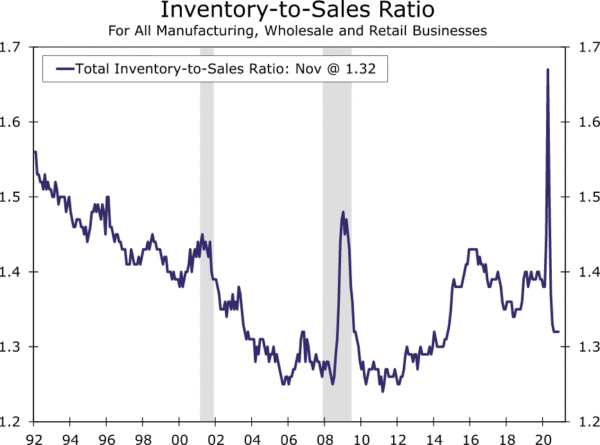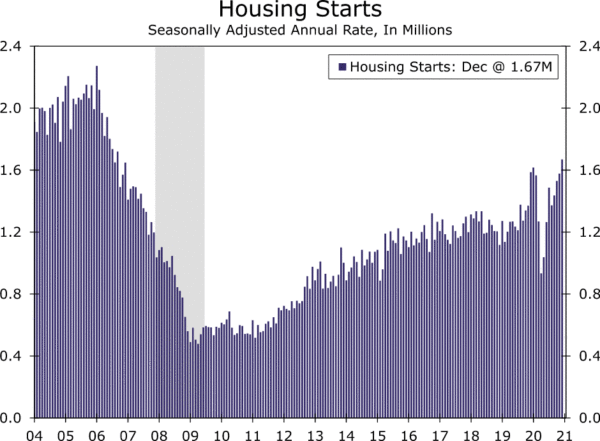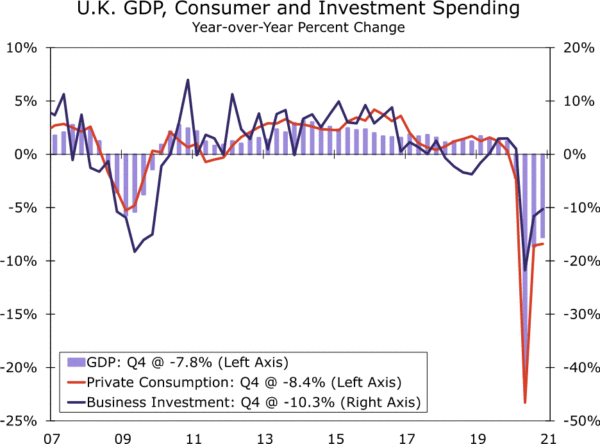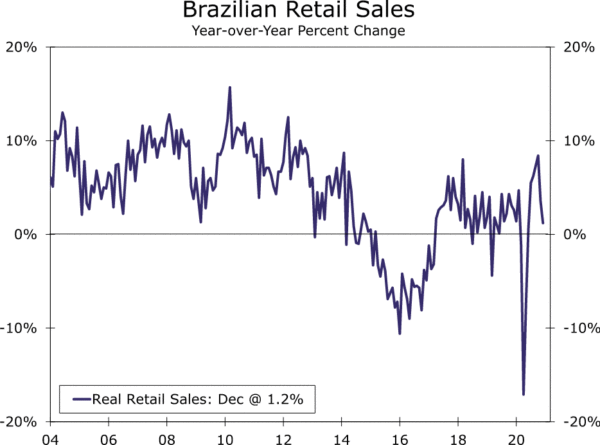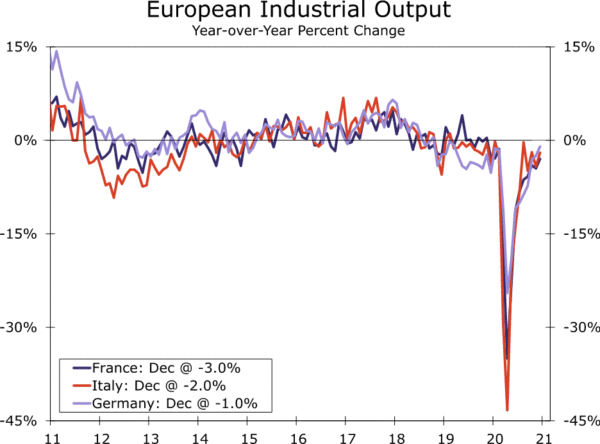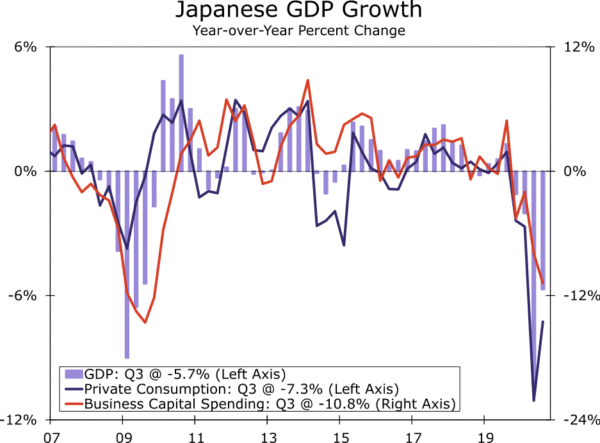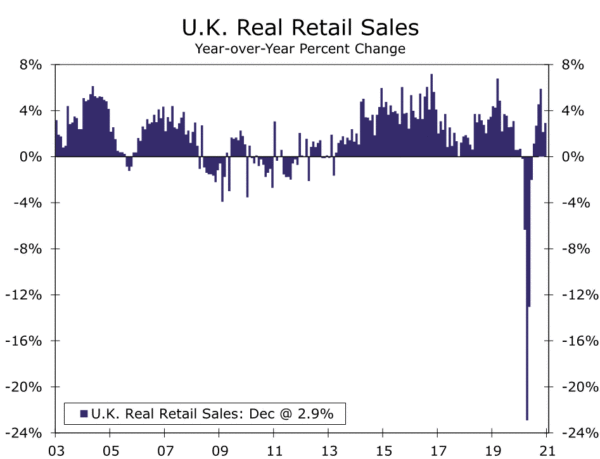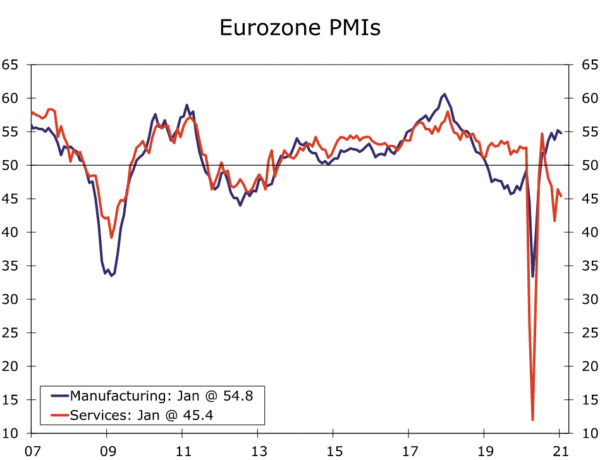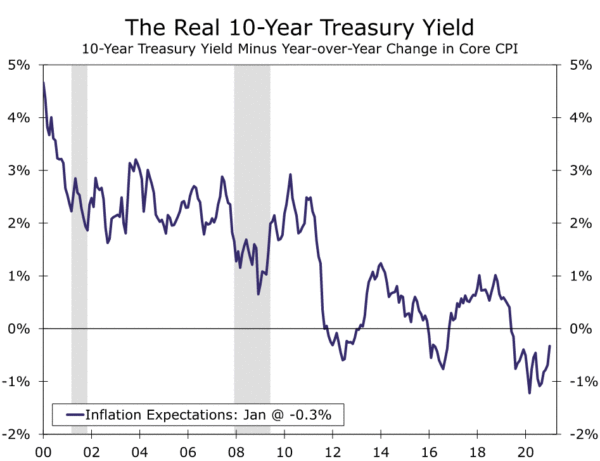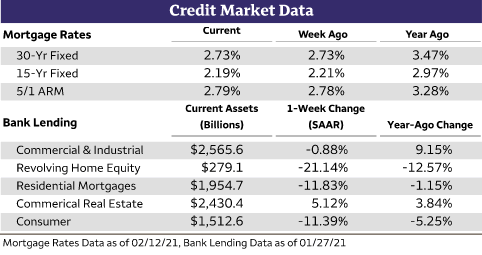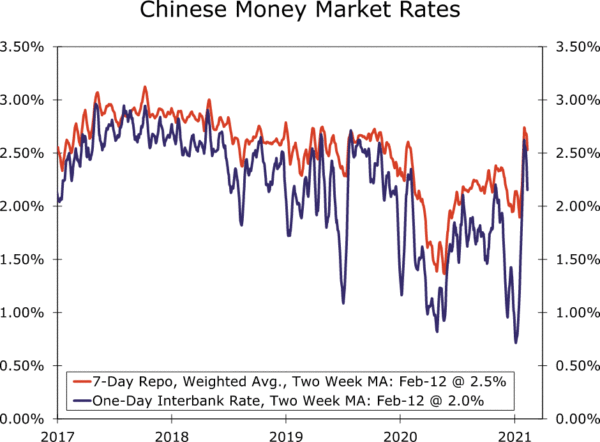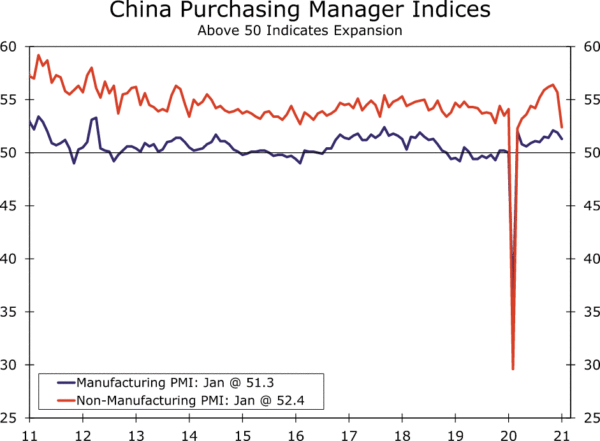U.S. Review
Inflation Comes Back in Focus
- Market attention was concentrated on the January consumer price data, as inflation has come back into focus. There is renewed concern among market participants that inflation is about to take off once the economy re-opens and demand accelerates. But, such concerns have not yet meaningfully presented themselves in consumer price data, with the core consumer price index unchanged for the month of January.
- While we expect inflation to firm later this year, we believe the Federal Reserve remains less concerned about inflation and more worried about labor market scarring. The labor market recovery continues to stumble, with an additional 793K workers having filed an initial claim for unemployment insurance last week.
- President Biden and Chinese President Xi had their first conversation this week since Biden was elected. Reports suggest numerous topics were discussed, but no new policy concerning tariffs was put in place.
Global Review
Mixed Finish to 2020, Soft Start to 2021
- The European economy showed mixed, albeit overall subdued, trends at the end of last year. United Kingdom Q4 GDP surprised to the upside with a 1.0% quarter-over-quarter gain. In contrast, national level manufacturing data for December from the Eurozone were mixed, and Eurozone-wide industrial output is expected to fall 0.5% for December. The mixed trends were not just in Europe, with Brazil reporting a large decline in December retail sales but an increase in December overall economic activity.
- While 2020 finished on a mixed note, it is likely that Europe’s economy will show further weakness in early 2021. February PMI surveys are due from both the Eurozone and the U.K. next week. While the services PMI is expected to rise modestly for both economies, they are also expected to remain below the breakeven 50 level. That suggests a further (Eurozone) or renewed (U.K.) contraction in economic activity, and we forecast Q1 GDP declines for both economies.
U.S. Review
Inflation Comes Back into Focus
It was a pretty quiet week in terms of economic data, with most market attention concentrated on the January consumer price data, as inflation has come back into focus. There is renewed concern among market participants that inflation is about to take off once the economy re-opens and demand accelerates. Inflation expectations have recently firmed, as higher input costs have pushed business inflation expectations to multiyear highs. Similarly, consumer inflation expectations have begun to trend higher. But, price acceleration has not yet meaningfully presented itself in consumer prices. The Consumer Price Index (CPI) rose 0.3% in January, but the gain was largely due to rising energy prices during the month. Excluding food and energy, core prices were unchanged from December, and over the past year, the core CPI is up just 1.4%, which is still significantly shy of the Fed’s 2% target.
That said, we do expect price growth to pick up over the course of the year. We recently made some fairly significant upward revisions to our 2021 and 2022 economic growth forecasts. Specifically, our outlook now makes the assumption that an additional COVID-fiscal relief package totaling roughly $1 trillion is passed by Congress sometime in March. With that in mind, we believe consumer spending, particularly on services, should ramp up markedly toward the second half of the year, as consumers rely on a mix of previously accumulated savings, still-flowing fiscal support and a pickup in job growth.
In this environment, prices are also poised to move higher. Low inventories and ongoing bottlenecks should continue to underpin goods inflation in the near term. But, once consumer spending begins to ramp back up, we expect service-sector inflation to be back in the driver’s seat. Consumers’ ample means to spend is set to collide with an eagerness to engage in activities put off by more than a year of social distancing. Shelter inflation (which represents a whopping 40% of the core CPI) should also begin its turnaround at that time, as the recent market conditions finally begin to be captured in the official CPI price data. After some low-base effects and support from oil prices, inflation in second quarter, our latest forecast has the 12-month change in the PCE deflator—the Fed’s preferred measure of inflation—runs modestly above 2% in the back half of the year and into 2022. Core inflation is also set to firm over that period.
Although inflation has come back into focus among market participants, we believe the Fed remains less concerned about inflation and more worried about long-term labor market scarring at present. Federal Reserve Chair Powell stressed the importance of delivering on the employment side of the central bank’s mandate in a speech this week. We suspect the Fed will look through any near-term rise in inflation and remain focused on securing the labor market recovery.
The labor market recovery continues to stumble. An additional 793K workers filed an initial claim for unemployment insurance last week. Although that marks an improvement from a week earlier, the staggeringly high amount of claimants speaks to a labor market recovery struggling to regain traction. The pandemic has undoubtedly made it more difficult for many workers to rejoin the workforce, while the expansion of unemployment benefits has likely also reduced some urgency to return to work. While just over half of all small businesses (51%) reported hiring or trying to hire workers in January, 90% of the firms hiring reported few or no “qualified” applicants. The labor market recovery should soon get back on track. As health concerns ebb alongside the pandemic, we expect stronger hiring conditions to pull workers back into the labor market.
In other news, President Biden and Chinese President Xi had their first conversation this week since Biden’s election. Reports of the call appeared to be cooperative, with numerous topics discussed, but no new policy concerning tariffs was put in place. Biden and his team have stressed that they intend to maintain a hard-line approach against China, and while they are reviewing actions taken by the Trump administration, we believe all tariffs will remain in place. China failed to meet its 2020 year-end purchase targets put forth in the U.S.-China Phase One trade deal, and purchases fell roughly 40% short of the target. See Topic of the Week for additional detail.
U.S. Outlook
Retail Sales • Wednesday
Retail sales had a somewhat disappointing end to 2020. After bouncing back quickly over the summer, sales at retail and food service businesses fell in each month of the fourth quarter. Spending that normally takes place during the holiday season was pulled forward, while a surge in COVID cases during the fall and winter led to new restrictions and a stalling of the nascent economic recovery.
As the calendar turns to 2021, we expect spending to regain some of its lost momentum and forecast retail sales to rise 0.7% in January. Our expectation for a turnaround is driven, in part, by continued strength in auto sales. Vehicle sales for January came in well ahead of expectations, rising to a 16.6-million annualized rate, the fastest pace since February of last year. Stripping out autos, we expect retail sales to grow about 0.2% in January, as the hangover from last year’s goods spending spree continues to weigh on overall sales. Going forward, we expect to see retail sales and consumer spending more broadly pick up steam. COVID case growth has decelerated materially from its winter high, allowing governments to remove some restrictions. Moreover, many consumers will have a bit more cash in their pocket to start the new year. The $600 economic impact payments that have begun to be distributed and the federal top-up to state unemployment benefits should help shore up incomes for the thousands who lost jobs in the most recent wave of layoffs.
- Previous: -0.7%
- Wells Fargo: 0.7%; Consensus: 0.8% (Month-over-Month)
Industrial Production • Wednesday
While consumer spending faded toward the end of last year, industrial production strengthened, rising 1.6% in December. Some of the better-than-expected gain was owed to a 6.2% jump in utilities output, but manufacturing output strengthened as well. The divergent paths of spending and production suggest that producers are building inventories after supply chain disruptions and surging demand for goods left inventories at their lowest level in six years.
While we forecast the pace of production to moderate to 0.5% in January, we expect this broader inventory-building trend to continue. For one, inventories are starting from a fairly lean level, as noted earlier. Moreover, demand for durable goods is unlikely to surge as it did last year, but producers are facing a number of supply chain disruptions, which could encourage them to continue bolstering supply stocks in the coming months.
- Previous: 1.6%
- Wells Fargo: 0.5%; Consensus: 0.4% (Month-over-Month)
Housing Starts • Thursday
Housing starts ended 2020 at their strongest monthly pace since 2006, despite continued weakness in multifamily starts. Single-family starts were up 27.8% in December, as builders tried to keep up with seemingly insatiable demand. Unlike many other parts of the economy, the housing sector boomed in 2020. That said, the sector has faced its share of setbacks. Since COVID restrictions curtailed construction last spring, builders have had difficulty finding workers and supplies. These headwinds have pushed builders into building more expensive homes and have broadly weighed on their ability to boost inventories, which remain near historic lows. These factors, along with the broader COVID-driven pull back in December, weighed on builder confidence in January. Likewise, we expect to see a slight moderation in housing starts to a still-high 1,642K-unit pace in January.
- Previous: 1,669K
- Wells Fargo: 1,642K; Consensus: 1,651K (SAAR)
International Review
U.K. Economy Ends 2020 on a Steady Note; Risks Remain for Early 2021
This week’s Q4 GDP data offered a fairly comprehensive look at the U.K. economy at the end of last year, with the report indicating growth was more resilient than expected as the year came to a close. Q4 GDP rose 1.0% quarter-over-quarter, more than the consensus forecast, although on an annual basis that still saw Q4 GDP fall 7.8% year-over-year. That said, government spending was the strongest area of growth with a 6.4% quarter-over-quarter gain. Business investment rose a more modest 1.3%, while consumer spending declined slightly, by 0.2%.
In terms of how the fourth quarter ended, December GDP rose 1.2% month-over-month, albeit after a large 2.3% decline in November. Service sector output jumped 1.7% month-over-month in December, while industrial output rose by a lesser 0.2%. Despite the Q4 increase, we believe renewed restrictions will result in a U.K. Q1 GDP decline, which we forecast to fall 3.0% quarter-over-quarter. Eventually, as further progress is made on vaccine distribution and the U.K. economy is able to re-open to a much greater extent, we see potential for a moderate economic recovery over time. We forecast U.K. GDP to rise by 3.3% for full-year 2021 and by 4.9% in 2022.
Renewed Clouds for Brazil’s Economy
Brazil’s economy experienced an encouraging rebound during the second half of 2020. Those gains were supported by fiscal stimulus, with emergency aid including monthly payments to informal workers, among other things. However, by late last year, as some of those emergency measures began to phase out, concerns about the economic outlook re-emerged. Such concerns were highlighted by the December retail sales report, which saw sales slump 6.1% month-over-month. Some of the categories perhaps most sensitive to stimulus payment showed large declines, as sales of clothing and shoes fell 13.3% month-over-month, personal and household items fell 13.8%, and sales of furniture and home electronics fell 3.7%. Despite the large decline in retail sales, Brazil’s measure of overall economic activity managed a 0.6% month-over-month gain in December.
Although the initial stages of Brazil’s rebound were relatively encouraging, as fiscal support lessens and given longer-term structural issues remain, we remain somewhat cautious about Brazil’s longer-term prospects. Our growth outlook is relatively conservative, anticipating a 3.9% increase in Brazil’s GDP in 2021 and a 2.4% increase in 2022.
Eurozone Manufacturing Finishes 2020 on a Sluggish Note
Over the past several days, national level data have highlighted some easing in momentum in the manufacturing sector across the Eurozone. Among the major economies Germany showed some resilience, with December industrial output unchanged for the month. In contrast, French December industrial output fell 0.8% month-over-month, while Italy’s industrial output dipped 0.2%. The exception to this sluggish trend was Spain, where December industrial output rose 1.1% month-over-month. Given the mixed national level figures, next week’s December Eurozone-wide industrial output is expected to slip by 0.5% month-over-month. Although survey data suggest that manufacturing activity has generally been less affected by renewed restrictions than the service sector, these December figures clearly point to some slowing in momentum in industrial activity.
These mixed signals are reflected in the European Commission’s updated economic forecasts published this week. The European Commission anticipates a 0.9% quarter-over-quarter fall in Eurozone Q1 GDP, which would follow the decline seen in Q4-2020. Overall, the European Commission lowered its 2021 GDP growth outlook to 3.8% (from a previously forecast gain of 4.2%), while it lifted its 2022 GDP growth outlook to 3.8% (from a previous forecast of 3.0%).
International Outlook
Japan GDP • Monday
Japan’s GDP figures due next week should show that economic growth continued into the final quarter of 2020, albeit with a noticeable slowing in momentum from Q3, as the renewed spread of COVID cases weighed on activity. The consensus forecast is for Q4 GDP to rise 2.4% quarter-over-quarter (not annualized), less than half the 5.3% growth seen in Q3. We believe the risks are tilted toward even slower growth, and see a gain of just 1.2%. Monthly activity data clearly point to the slowing in economic momentum late last year, as both retail sales and industrial output recorded back-to-back monthly declines in November and December.
The GDP figures are not the only data due from Japan next week. December services activity (the Tertiary Activity Index) is expected to fall 0.6% month-over-month, while December core private machinery orders are expected to fall by 6.1%. The February manufacturing and service PMIs due next Friday will also be closely scrutinized for insight into how Japan’s economy is faring in early 2021.
- Previous: 5.3%
- Wells Fargo: 1.2%; Consensus: 2.4% (Quarter-over-Quarter)
U.K. Retail Sales • Friday
After the U.K. economy managed positive growth in the final quarter of 2020, January retail sales figures will be closely scrutinized for insight into how the renewed spread of COVID cases and associated restrictions are affecting the economy in early 2021. U.K. GDP is expected to show another contraction, with the Bank of England looking for a 4% quarter-over-quarter Q1 GDP fall. We are forecasting a smaller 3% decline. With respect to the retail sector, survey data point to a soft January. The Confederation of British Industry retailers’ survey saw a drop in the reported sales balance close to the lows seen in April and May of last year. For the official January retail figures, the consensus forecast is for sales for decline 1.0% month-over-month.
The U.K. February PMI surveys will also provide insight into how the economy is faring early this year. The services PMI, which slumped in January, is expected to recover moderately in February to 42.0, while the manufacturing PMI is expected to decline to 53.0.
- Previous: 0.3%
- Consensus: -1.0% (Month-over-Month)
Eurozone PMIs • Friday
Eurozone GDP showed some resilience in late 2020, but given the renewed spread of COVID cases and associated restrictions, the economy is expected to show further weakness in early 2021. Eurozone Q4 GDP fell a relatively moderate 0.7% quarter-over-quarter with Germany, the region’s largest economy, managing to eke out a 0.1% gain. However, another decline in Eurozone GDP does appear to be in store for Q1-2021.
The Eurozone PMI surveys might provide some insight into just how weak Eurozone Q1 GDP might be. The services PMI, in particular, remains at levels consistent with a further contraction in the Eurozone economy in Q1 this year. The Eurozone services PMI fell in January and, in fact, has been below the breakeven 50 level for five months in a row. The consensus forecast is for the services PMI to rise slightly to 45.9 in February, which would still be below that breakeven level. Manufacturing activity has held up better so far, although the February manufacturing PMI is also expected to decline, to 54.4.
- Previous: 54.8, 45.4
- Consensus: 54.4 (Manufacturing), 45.9 (Services)
Interest Rate Watch
Inflation Concerns Remain Contained, So Far
January’s benign CPI data and soothing comments from Fed Chair Jay Powell appear to have alleviated any incipient fears about inflation that might have crept into the market earlier this week. While the yield on the 10-year Treasury briefly tested the 1.20% level, yields fell back after digesting this week’s new supply of debt. Powell made it clear that unemployment remains the primary area of concern for the Fed, despite the most recent drop in the unemployment rate to 6.3% and growing forecast that calls for the jobless rate to fall well-below 5% by the end of 2022. Powell noted that the real unemployment rate was closer to 10%, alluding to the substantial drop in labor force participation, particularly among women and minorities. Powell and other Fed officials have also expressed concern about scarring from the pandemic, where skills have atrophied among those out of work for long periods of time or who have seen their education and job training disrupted.
For the financial markets, the Fed continues to make it abundantly clear it intends to keep short-term interest rates near zero and continue to expand its balance sheet until the gains from economic growth are spread more broadly across society. That means interest rates are likely to remain low for the foreseeable future, with the yield curve steepening modestly as economic growth improves and inflation moves back toward the Fed’s 2% target.
The first real test for the financial markets and the Fed will come this spring, when economic growth is expected to ramp back up and the year-over-year change in the CPI will pop up due to weak year-over-year comparisons. The Fed has already made it clear that it believes any early flareups in inflation due to base effects or supply chain disruptions are transitory.
History would appear to be on the Fed’s side. Inflation tends to decelerate during the first two years of an economic recovery, as output tends to improve ahead of employment, resulting in a productivity boost. The risk for the financial market is that stimulus package being proposed by the Biden administration might come online just as the economy is gaining momentum, leading to a larger-than-expected acceleration in inflation. In the short run, such an acceleration will be hard to differentiate from the transitory inflationary pressures the Fed is preparing the markets for.
Topic of the Week
China Stays Strong in the Year of the Ox
Thursday marked the first day of the Chinese Lunar New Year (LNY), signaling a fresh start after a year full of hardship. Relative to last year when Lunar New Year celebrations were disrupted by the original spread of COVID, this year travel, shopping, cash gifting and other forms of consumer spending should be more “normal” as the pandemic is largely under control in China. In order to facilitate these high levels of spending and monetary gifting, the PBoC will likely aim to make liquidity more accessible and cheaper over the next two weeks. As expected, money market rates in China have come down ahead of the LNY in order to accommodate these local traditions. Going forward, even past LNY celebrations, we have a bias for believing local money market rates will continue to modestly edge lower. Up to this point, the PBoC had been sporadically removing liquidity from China’s financial system in order to protect against the threat of “bubbles” in local Chinese risk assets. However, we believe Chinese authorities will be cognizant of removing economic support from the economy too early and keep policy accommodative for the time being.
While not exactly customary, the Lunar New Year also brought the first communication between Joe Biden and Chinese President Xi. Reports suggest numerous topics were discussed, although the focus of the call seemed to be U.S. concerns related to China’s aggressions in Hong Kong and Taiwan, as well as possible human rights violations in Xinjiang. In addition, economic policies undertaken by China were also reported to be discussed; however, no new policy concerning the tariffs put in place under the previous U.S. administration was agreed to. For the time being, we expect the Trump era tariffs to be in place for the foreseeable future and do not expect significant changes to China policy under the Biden administration. We do, however, expect Biden to take a more unified approach against China as opposed to the Trump administration’s bilateral strategy. We expect the U.S. to seek help from the European Union and other major trade partners to take coordinated action against China to enact change.
COVID Impact Remains in Question
As mentioned, China has been successful in largely containing the spread of COVID; however, renewed outbreaks of cases have been reported in multiple provinces surrounding Beijing. The number of people instructed to quarantine has now climbed to over 20 million. Depending on how long it takes Chinese authorities to control these hotspots, the reinstated lockdowns and additional restrictions could have a more pronounced impact on economic data than we have seen so far. Following the pickup in cases in January, China’s manufacturing PMI fell slightly to 51.3 from 51.9 and its non-manufacturing PMI slipped to 52.4 from 55.7. Restrictions have not yet appeared in other economic data, although new lockdowns are also part of the reason we expect the PBoC to keep policy accommodative for the time being.
Despite some downside risk as it relates to lockdowns, we are still optimistic on the prospects for the Chinese economy in 2021. As of now, we forecast GDP will grow over 9% this year, a solid rise coming off of a 2.3% expansion in 2020.




